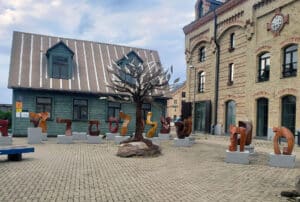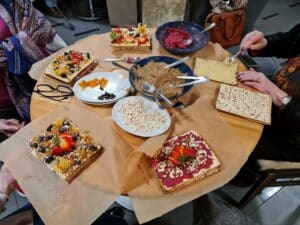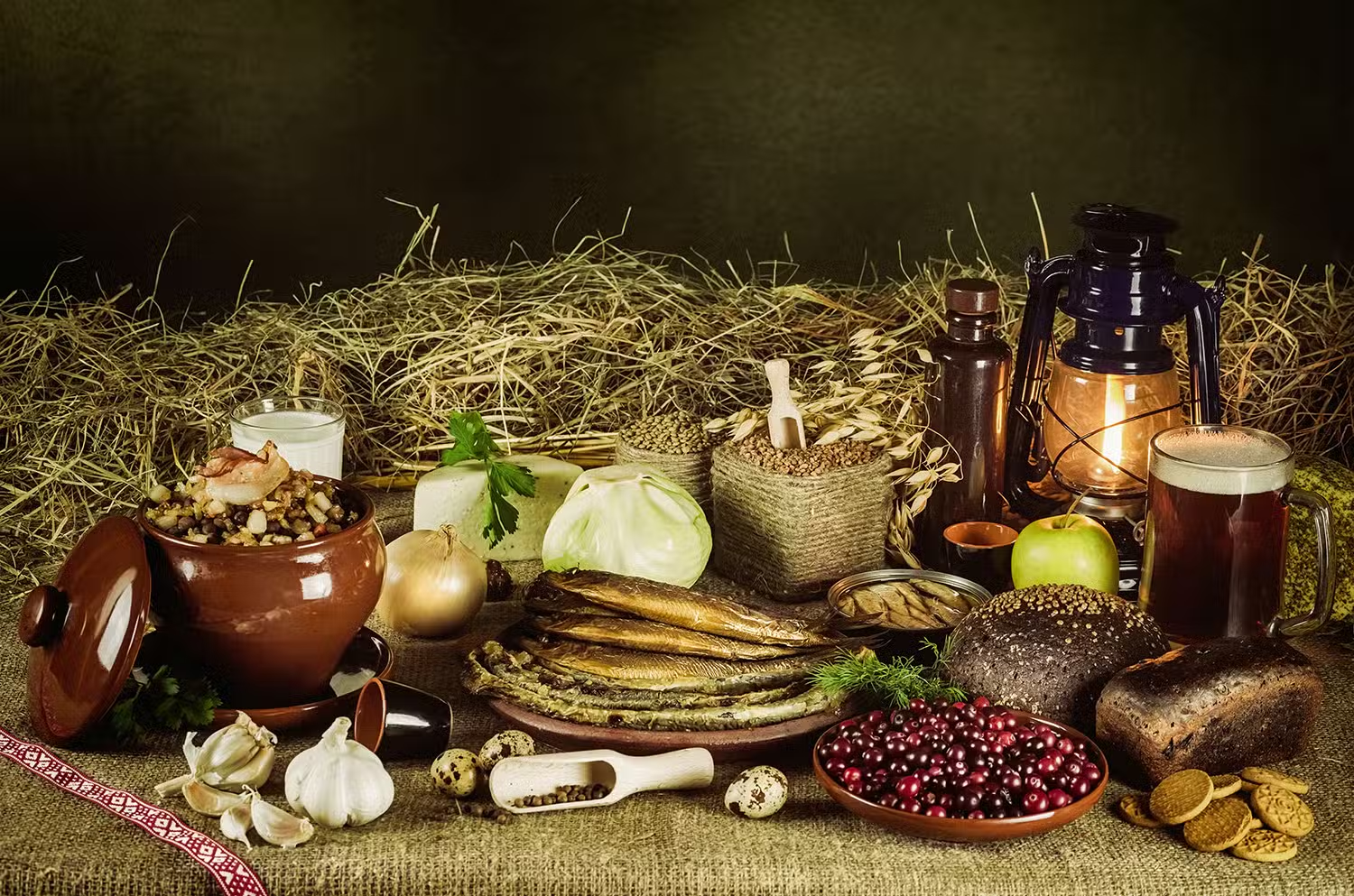This guide offers advice to Jewish students considering study abroad programs in Latvia. Here, you’ll read about the local Jewish history, Latvia’s active synagogues, staying kosher, and about some of Riga’s major Jewish cultural organizations, museums, and memorials. Most importantly, we’ll get you on your way to engaging with the local Jewish community and comfortably celebrating your traditions and identity while abroad.
A Brief History of Jews in Latvia
Little is known about Jewish history in Latvia before the 16th century. Before the 13th, the region was one that traders often interacted with, but rarely settled in. While Jews may have been among these merchants, no record of this exists. There are Jewish headstones that date back to the 13th century, indicating that individual Jews were present. However, the papal state of Livonia, which ruled the area for most of the 13th-16th centuries, denied entry to Jews. Thus, any Jewish presence during those times tended to be exceptional. Few records exist documenting these individuals. For more on the general history of Latvia, see this article from our sister site, GeoHistory.

Latvia’s Jewish history is thus usually said to begin in 1571. At that time, the Livonian Wars had largely broken papal power. Denmark came to control what would become part of Eastern Latvia’s province of Courland. Hoping to develop the local economy, the Danish prince invited a group of well-educated, German-speaking Jewish traders and craftsmen to settle near Piltene, a small trading town on the Venta River.
More German-speaking Jews eventually followed and the community was able to spread to other urban areas and integrate well with the urban ruling classes, which, due to colonization under the Livonian state, was also well-educated and German speaking.
Yiddish-speaking Jews, primarily Ashkenazi, began arriving to Latvia in the 17th and 18th centuries. Fleeing the anti-Semitism and pogroms that devastated much of Eastern Europe, these Jews settled mostly in Riga and Daugavpils, which were then ruled by The Polish-Lithuanian Commonwealth. The Polish state had long fostered good relations with Jews and had one of the largest Jewish populations in Europe at the time.
The Yiddish-speaking Jews were, overall, not as educated and much poorer than the German speaking Jews already present. Yiddish-speaking Jews did not integrate as well either. They instead formed tight communities of support focused on preserving their culture and language. These communities came to include their own schools, theaters, and newspapers.
By the 20th century, Latvia had a large, diverse, and active Jewish population of around 200,000 – probably just under 10% of the population. Unfortunately, this population would be decimated over the course of that century.
The destruction of WWI, for instance, saw the Latvian population reduced by 20%, and its Jewish population by about 50%. When independent Latvia was overtaken by the USSR just before WWII, the Soviets deported a majority of Latvia’s Jews as potential political dissidents. Many died in the horrendous conditions enroute to Central Asia or Siberia. Those that remained in Latvia were soon under Nazis rule. As few as 200 Jews remained in Latvia after Holocaust.
After WWII, Jews returning from elsewhere in the USSR brought the population back up to about 34,000. However, “waves” of Jewish emigration occurred in the 1970s, mostly to the US and Israel, and due to the economic hardship that followed the collapse of the USSR.
Today, Latvia is home to about 8,000 Jews, mostly centered in Riga, mostly Ashkenazi, and mostly Latvian speaking. There are active synagogues in Riga, Daugavpils, and Jurmala serving growing Jewish communities. Jurmala’s synagogue, in fact, is new – having opened 2019 in part to accommodate the many Jews that vacation in the resort city every summer.
Synagogues in Latvia
Peitav Synagogue is the only Jewish house of worship in Riga to have survived the Nazi occupation. Originally built in 1905, it was Riga’s second largest synagogue. Refurbished in 2009, it is today open daily except for Saturdays. Today it is also known as the “Riga Synagogue” or the “Peitav-Shul Synagogue.”

Chabad Lubavitch Latvia offers weekday, Shabbat and Holiday prayers.
The Beit Israel Synagogue in Jurmala opened in 2019 as Latvia’s first new synagogue in decades. Its architecture is meant to recall the wooden architecture that was once common for many synagogues in Latvia. The interior, however, is opulent and meant to celebrate the resurgence of Jewish culture in the area.
Kaddish Synagogue of Daugavpils was built in 1850. Devastaed by the Nazis in WWII, it was restored by local authorities afterwards. It underwent additional renovations in 2003-2005. There is a museum on the second floor dedicated to local Jewish history. Although the Synagogue is active, it is requested that visitors call ahead to make appointments as there is not someone always on site.
Jewish Organizations in Riga
The Jewish Community of Riga is a vibrant organization that serves as the heart of Jewish life in the city. It offers a range of religious, educational, charity, employment, and cultural services, supporting the continuity and revival of Jewish traditions and their integration into modern society.
Chabad Lubavitch Latvia offers a number of community services including a youth club and a student lounge.
The Center for Judaic Studies at the University of Latvia is an academic institution dedicated to the study and research of Jewish history, culture, and religion. It plays a crucial role in promoting Jewish scholarship and fostering intercultural dialogue within the academic community and beyond.
Sites of Interest in Riga

Riga Ghetto and Latvian Holocaust Museum seeks to tell the story of Latvia’s Jews. The museum itself is located on the edge of what was onece the Riga Ghetto.
The Jewish Museum of Riga provides an insightful exploration into the rich Jewish history and culture of Latvia. Through its exhibitions, it showcases the community’s contributions to Latvian society, the tragic events of the Holocaust, and the Jewish experience in the Soviet era, fostering understanding and remembrance.
The Monument to the Great Choral Synagogue, is essentially the preserved remains of the monumental building that was once Riga’s largest and most prized synagogue. Destroyed by fire by the Nazis during World War II, the site now serves as a poignant reminder and memorial to the devastating impact of the Holocaust on Latvia’s Jewish community.
The Jewish Cemetery of Riga, with its historic graves and monuments, serves as a testament to the long-standing Jewish presence in the city. It offers a somber reflection on the past, honoring prominent Jewish figures and the many lives that shaped the community over centuries.
The Rumbula Memorial stands at the site where more than 25,000 Jews were killed in the Rumbula Forest on the outskirts of Riga.
The Bikernieki Memorial honors the more than 20,000 Jews and other minorities who were killed in the Bikernieki Forest on the outskirts of Riga.
The Old Synagogue Kar Schul of Riga is a former synagogue that structurally survived being set on fire by the Nazis. After the war, the Soviets turned it into an apartment building. It remains so today, but is also a site of pilgrimage for Jewish history buffs.
The State Historic Archives of Latvia houses an extensive collection of documents related to the history of Jews in Latvia. These archives provide a vital resource for historians, genealogists, and anyone interested in exploring the multifaceted aspects of Jewish life and history in the region.
Staying Kosher in Riga

Latvian cusine is heavy on pork and the Jewish community in Riga is small. However, it is still possible to remain kosher in Riga!
This section on staying kosher was written by guest author Marina Garfield, a Jewish student from the University of Texas at Austin who studied with SRAS in Riga over the summer of 2024.
The Basics
- Traif – Traif foods are foods that are explicitly not kosher, as outlined in the Torah. These include pork, shellfish, and any of their derivatives (such as gelatine or lard). Traif foods can never be kosher.
- Pareve – Pareve foods are foods that are neither meat nor dairy, and as such, can be eaten after eating meat. All vegetables are pareve, as well as eggs, most bread, and fish.
- Kosher-certified Meat – Even though traif foods are off limits, some people will not eat any meat that is not certified kosher by a rabbi.
- Kosher Symbols – In the US, it is easy to find kosher-certified foods by checking for the U or K symbol. In Latvia, however, I found that very few products had those symbols (unless they were made in Israel or the US for export). Some people are not comfortable eating anything that does not contain a certification symbol, but this was not an issue for me, personally (again, this varies from person to person). The lack of any certification symbol made shopping more tedious, since I had to individually check every ingredient.
- Meat and Dairy – Some people who keep kosher, like myself, will not mix meat and dairy in the same meal. This means that some dishes, such as borscht with sour cream, are off limits. Furthermore, I am unable to eat something with meat in it and follow it with a dairy product. For example, I won’t have some chicken shashlik followed by a khachapuri.
- Kosher-style – A way of keeping kosher that does not involve following all of the laws. There is no one way to follow a kosher-style diet. For example, I don’t eat traif or mix meat and dairy, but I will eat beef or chicken that is not kosher-certified, but another person who eats kosher-style might mix meat and dairy, yet never eat traif food.
- Final Reminder – Since keeping kosher can differ greatly from person to person, one should always ask which rules of kosher somebody observes in order to best accommodate them. It is always better to ask rather than make assumptions about what a person can or cannot eat.
Restaurants
At restaurants, I need to pay close attention to which dishes I can eat. Every vegetarian dish will be considered kosher, but when I want to eat meat, I have to make sure that I am either eating chicken, lamb, or beef. Sometimes, items such as meatballs are made with a mixture of pork and beef. Because of this, I usually asked the waiter to clarify what meat is in a dish, even if it is written on the menu.
Another common issue I encountered was not knowing whether or not a meat dish is made with a dairy product. With some dishes, the answer is obvious: a cheeseburger will always have dairy mixed with meat. If that is the case, I will usually ask for the dish without dairy. However, a dish like “beef in sauce” is harder to decipher since the sauce could be made with cream, cheese, or butter. When asking about ingredients, it is important that I ask clearly and with precision. I first assessed whether it was better to speak in Russian or English. At more modern establishments, I can get away with asking in English, but every now and then, a waiter indicated that they were more comfortable speaking in Russian. Occasionally, out of an abundance of caution, I would ask for sauce on the side. This allowed me to taste it (or ask a friend to taste it) before mixing it into my meal.
A Few Kosher Restaurants in Riga:
Chabad Lubavitch Latvia hosts a store with kosher products, a list on their website with kosher products that can be found in most grocery stores in Riga, and they offer Shabbat meals following prayers. If you are interested in joining Shabbat, please register by the preceding Thursday on their site.
Cafe Lechaim is a kosher meat restaurant serving Ashkenazi dishes. It is associated with Chabad, although at a different location.
Kafe 7:40 is a kosher meat restaurant associated with and based at the Jewish Community Center.
A More Widely Available Option:
Lido is a popular restaurant chain in Latvia that differs from traditional restaurants, as it operates similarly to a cafeteria. Instead of choosing from a menu, patrons grab a tray and manually select each dish they would like. Restaurants like these are certainly easier, as I have more control over which ingredients are in my meal. Furthermore, there are plenty of meal variations depending on whether I want to eat dairy or meat.

However, even at Lido, I had to be vigilant about what ingredients were in my dishes. Usually, the names of the dishes are written in English and Russian, whereas the individual ingredients were listed in Latvian. Several times, I saw a dish that doesn’t list dairy in its description clearly have cheese. Other times, I noticed that a dish said one thing in English and another in Russian. Usually, descriptions like “minced meat” were too vague for me to trust, so I opted for a safer choice. Even though apps like Google Translate and Yandex Translate are readily available on my phone for situations like these, it can be cumbersome to individually translate every single plaque.
Sometimes, it was difficult to know which dish a plaque refers to, especially when there were many meat dishes that looked the same. It is almost impossible to distinguish chicken shashlik from pork shashlik just by looking at it. Therefore, I usually returned to the same three or four dishes, which I was sure wouldn’t contain any traif or dairy (if I am choosing to eat meat that day).
Shopping Kosher in Riga

In Latvia, I chose to stay at a hostel rather than live with a host family. Luckily, there was a Rimi (a popular supermarket chain) a block away from the hostel. Because of this, I was responsible for cooking my own meals. Shopping for my own food allowed me to spend time individually reading each ingredient list and translating items when needed. In a supermarket setting, there is a lot less pressure to quickly choose what you want than if you are shopping at a farmer’s market, for instance. Furthermore, staying at the hostel allowed me to better plan my meals and buy enough dairy and pareve foods. I would typically buy lots of vegetables and a few frozen dinners at the supermarket.
- Frozen Foods: Since frozen meals are easy to make after a long day at school, I found myself stocking up on some premade frozen foods for days in which I was too tired to cook. The Rimi next to the hostel offered several cheap pelmeni options, but many bags were not labeled, meaning I would have to read the ingredients on the back closely. Like the meat, some pelmeni were labeled as chicken, beef, or pork, but most bags didn’t have any identifying information easily visible. For example this bag of pelmeni was a great deal and didn’t say anywhere that the filling was pork. It was only when I read the tiny ingredients list that I found out the dumplings were 31% pork, making them unkosher. Other times, a product would be written completely in Latvian and I did not want to risk accidentally buying a traif product. Regardless, I usually opted for vegetarian pelmeni since I enjoy eating them with sour cream, a dairy product.
-
- As a side note, many sour creams in the United States are made with lard, making them not kosher. This didn’t seem to be as big of an issue in Latvia, where there were fewer preservatives in foods. However, it is still worth checking to see if any products contain lard.
Sometimes, I would buy a frozen pizza for dinner. There was only one option that did not have meat on it, so for variety, I would often buy fresh vegetables to create my own unique “toppings.”
- Premade Foods – During class breaks, my friends and I liked to stop at a Rimi or a Narvesen for a quick lunch. These establishments offered premade sandwiches with either pork, chicken, or fish. At Narvesen, you could even get your sandwich heated in the back! However, since most of these sandwiches had cheese with the meat, I was unable to eat them. Other premade dishes were unclear about which kind of meat was used, so I usually skipped those, too.
Snacks – Almost every snack in Riga was kosher, with the exception of bacon-flavored chips and candies with gelatin. Luckily, the candy in Rimi was labeled as “gelatin-free” when applicable, making shopping for that easier. However, it was always worth doing a double-check to make sure that the labels were accurate.
Program-led Excursions
For the most part, since my dietary restrictions were made clear in advance to the program coordinator, I didn’t have too many issues on program-led meals. It is comforting to know that someone else understands my dietary restrictions and will accommodate them. I appreciated being asked about which foods I could eat. However, there were occasions when it was assumed that I would just be “eating vegetarian,” and the vegetarian option was not of comparable quality to the meat option. This led to a very exclusionary experience, especially since the issue could have been easily prevented if the program coordinator had reached out to me and/or the restaurant beforehand to ask about non-pork options.
Antisemitism and Acceptance
Latvia is safe for Jewish travel and hosts hundreds of Jewish tourists every year. Thanks to a rapidly improving environment for Jews, the Jewish population has grown by about 25% since 2011, mostly from Latvian Jews returning from emmigration and from Jews from Russia and Eastern Europe emigrating to Latvia. There is no need to hide your identity here and openly wearing Jewish symbols and clothing is accepted. That said, antisemitism and far right movements do exist here. Just take the same general safety precautions that anyone would need to take when visiting a major city. While you are just as likely to see passing evidence of antisemitism in Latvia as you are anywhere else, students who have visited Latvia have reported an overwhelmingly positive experience.
Before Your Trip
Before you go, here are a few tips from previous Jewish students who have stayed in Latvia:
- If you plan on visiting the Riga Chabad, send an email or text to the Rabbi before arrival to ask any questions and clarify details for your visit.
- Communicate with SRAS, your instructors, and guides to discuss accommodations for Shabbat, meals, and any other concerns.
- Attend all SRAS briefings and always research the history and peruse news sources about any destination you travel to. This will help you learn more about Latvia and keep yourself safe.
Safe travels, and enjoy your time in Latvia!
You’ll Also Love

Dictionary of Latvian Food
Latvian cuisine shows strong influence from German, Scandinavian, and Slavic sources. It also has many fundamentally Latvian traditions that are often overlooked by outsiders but which are deeply cherished locally. Latvian cuisine is heavy on pork, potatoes, fermented dairy, and pickled vegetables. Herring and lampreys from the Baltic Sea and local rivers provide delicacies that […]

Jewish Latvia: A Brief History and Guide
This guide offers advice to Jewish students considering study abroad programs in Latvia. Here, you’ll read about the local Jewish history, Latvia’s active synagogues, staying kosher, and about some of Riga’s major Jewish cultural organizations, museums, and memorials. Most importantly, we’ll get you on your way to engaging with the local Jewish community and comfortably […]

Olivier and Rasols Salads: Holiday Traditions With Fascinating Histories
Russia’s Olivier Salad (Салат «Оливье») and Latvia’s rasols are well-known staples of their respective cuisines and common additions to holiday tables. Today, the recipes for both are quite similar, with chopped vegetables, egg, and meat dressed with mayonnaise. Olivier is now eaten throughout the former USSR and has even become common as “Russian Salad” in […]

Pierogi, Pīrāgi, Varenyky: A Tour of Pastries and Dumplings
The dumplings and pastries of Europe’s northeastern flank have a story to tell. Their recipes, etymologies, and related traditions are intertwined in a complex historical knot. There are so many ancient connections that it is almost impossible to say which influenced the next. And yet, each dish is held up as a unique and integral […]

Latvian Identity: Understanding the Latvian National Narrative
This resource analyzes Latvian national identity through a selection of Latvian national heroes, pivotal events in Latvian history, geography in the Latvian national consciousness, and the role of religion, language, and ethnicity in the Latvian understanding of what it means to be Latvian. It will also briefly cover ethnic diversity in Latvia. The intent is […]





